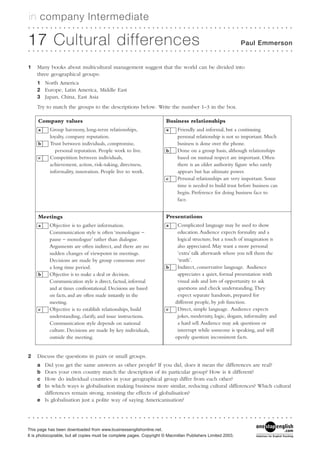
Cultural differences countries
- 1. in company Intermediate ............................................................ 17 Cultural differences Paul Emmerson ............................................................ 1 Many books about multicultural management suggest that the world can be divided into three geographical groups: 1 North America 2 Europe, Latin America, Middle East 3 Japan, China, East Asia Try to match the groups to the descriptions below. Write the number 1–3 in the box. Company values a b c Group harmony, long-term relationships, loyalty, company reputation. Trust between individuals, compromise, personal reputation. People work to live. Competition between individuals, achievement, action, risk-taking, directness, informality, innovation. People live to work. Business relationships a b c Meetings a b c 2 Objective is to gather information. Communication style is often ‘monologue – pause – monologue’ rather than dialogue. Arguments are often indirect, and there are no sudden changes of viewpoint in meetings. Decisions are made by group consensus over a long time period. Objective is to make a deal or decision. Communication style is direct, factual, informal and at times confrontational. Decisions are based on facts, and are often made instantly in the meeting. Objective is to establish relationships, build understanding, clarify, and issue instructions. Communication style depends on national culture. Decisions are made by key individuals, outside the meeting. Friendly and informal, but a continuing personal relationship is not so important. Much business is done over the phone. Done on a group basis, although relationships based on mutual respect are important. Often there is an older authority figure who rarely appears but has ultimate power. Personal relationships are very important. Some time is needed to build trust before business can begin. Preference for doing business face to face. Presentations a b c Complicated language may be used to show education. Audience expects formality and a logical structure, but a touch of imagination is also appreciated. May want a more personal ‘extra’ talk afterwards where you tell them the ‘truth’. Indirect, conservative language. Audience appreciates a quiet, formal presentation with visual aids and lots of opportunity to ask questions and check understanding.They expect separate handouts, prepared for different people, by job function. Direct, simple language. Audience expects jokes, modernity, logic, slogans, informality and a hard sell. Audience may ask questions or interrupt while someone is speaking, and will openly question inconsistent facts. Discuss the questions in pairs or small groups. Did you get the same answers as other people? If you did, does it mean the differences are real? Does your own country match the description of its particular group? How is it different? How do individual countries in your geographical group differ from each other? In which ways is globalisation making business more similar, reducing cultural differences? Which cultural differences remain strong, resisting the effects of globalisation? e Is globalisation just a polite way of saying Americanisation? a b c d ............................................................ This page has been downloaded from www.businessenglishonline.net. It is photocopiable, but all copies must be complete pages. Copyright © Macmillan Publishers Limited 2003.